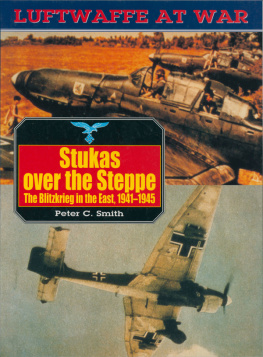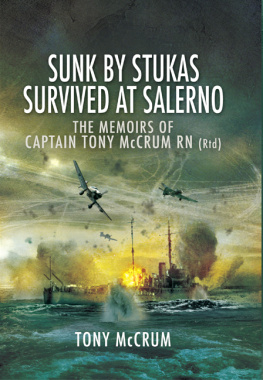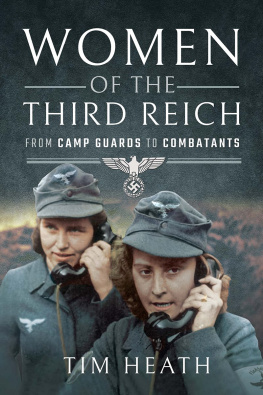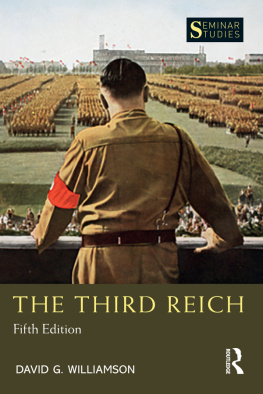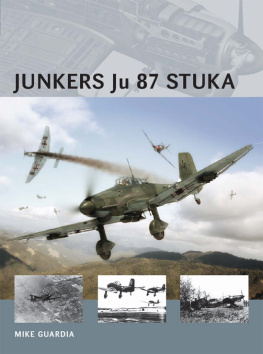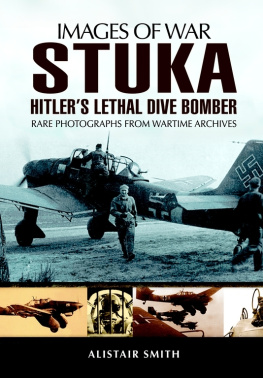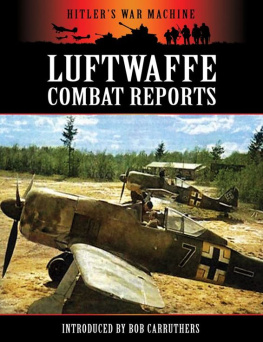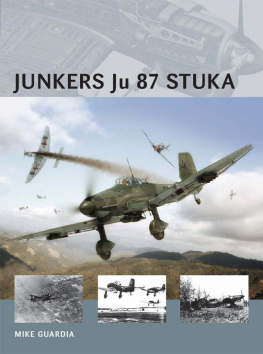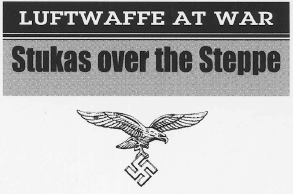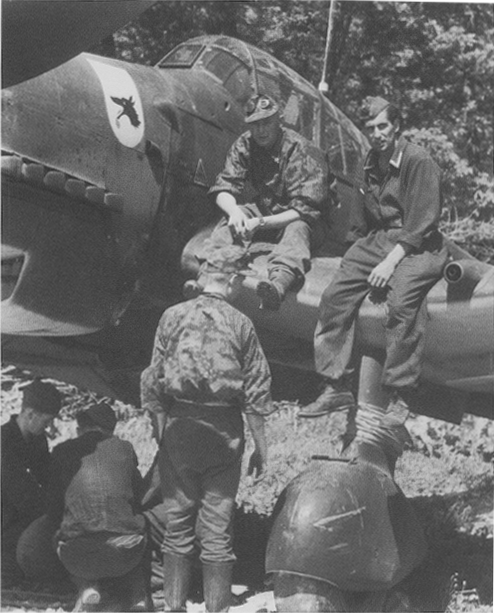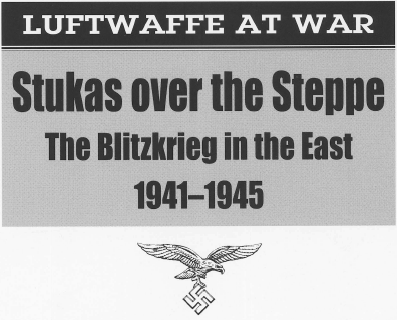While armourers work on the main bomb beneath the fuselage, other members of the Stab./St.G. 77 relax in the dappled sunlight of nearby woods while this Dora-3 is made ready for her next mission. Note that her pilots front windscreen has the normal addition of a flat, 50mm armoured glass windshield with extra bracing, behind which is located the Revi C-12-C bombsight. For further protection the seat-mounted headrest was fully armoured as was the overturn structure immediately abaft it. (James V. Crow)
Peter C. Smith
Frontline Books
To the memory of Heinz Sellhorn and Peter Schwartzkopff for their friendship and enormous help
Stukas over the Steppe
First published in 1999 by Greenhill Books
published in this format in 2015 by
Frontline Books
an imprint of
Pen & Sword Books Ltd
47 Church Street, Barnsley, S70 2AS
www.frontline-books.com
Copyright Peter C. Smith
The moral right of the author has been asserted
The right of Peter C. Smith to be identified as the author of this work has been asserted by him in accordance with the Copyright, Designs and Patents Act of 1988.
All rights reserved. No part of this publication may be reproduced, stored in a retrieval system or transmitted in any form or by any means, electronic, mechanical or otherwise without the written permission of the Publisher.
British Library Cataloguing in Publication Data
Smith, Peter C. (Peter Charles), 1940
Stukas over the Steppe: the Blitzkrieg in the east,
19411945. (Luftwaffe at war; v. 9)
1. Germany. Luftwaffe History 2. World War,
19391945 Aerial operations, German 3.World War,
193945 Campaigns Soviet Union 4.Stuka
(Bombers) History I.Title
940.544943
ISBN 1-85367-355-2
Library of Congress Cataloging-in-Publication Data
Smith, Peter Charles, 1940
Stukas over the steppe: the Blitzkrieg in the East,
19411945/Peter C. Smith,
p. cm. (Luftwaffe at war; v.9)
ISBN 1-85367-355-2
1. World War, 19391945 Aerial operations, German. 2. World War, 19391945 Campaigns Soviet Union. 3. Lightning war. I. Title. II. Series.
D787.S6 1999
940.544943-dc21 | 9849194
CIP |
Designed by DAG Publications Ltd
Designed by David Gibbons
Layout by Anthony A. Evans
Printed in Singapore
LUFTWAFFE AT WAR
STUKAS OVER THE STEPPE THE BLITZKRIEG IN THE EAST
19411945
The launching of the German attack on the Soviet Union on 22 June 1941, Operation BARBAROSSA, was the ultimate and logical climax to the road that the Fhrer Adolf Hitler had taken since he came to power in 1933. The Communist had long been the ideological enemy of the Nazi state, and that state had been built with the avowed intent to create Lebensraum (living space) for the German people at the expense of the Slavs of central and eastern Europe. The fact that the lands he coveted were under the domination of his most hated opponents only lent inevitability to Hitlers fateful decision. Marshal Joseph Stalins aggression the attack on Finland, the occupation of Estonia, Latvia and Lithuania, the annexation of parts of Romania drew the Soviet Union closer to Germanys eastern borders and added fuel to the fire of deep resentment that Hitler felt towards Russia, making the final confrontation a certainty.
Neither was there much doubt about the methods by which the German armed forces meant to take on and defeat the huge military machine that Stalin had built up over the years. Far outnumbered in everything infantry divisions, artillery, tanks and aircraft the Germans still took on the task with supreme confidence. This was due to the fact that their military and aviation strength had been tried and tested in full combat. In Blitzkrieg operations against Poland, Norway, the Netherlands, Belgium, France, Yugoslavia and Greece, the highly mobile and fast-moving combination of armoured column thrusts, supported by the flying artillery provided by the dive-bombing Junkers Ju 87 Stuka (Sturzkampfflugzeug dive-bomber) units, had proved irresistible.
In campaign after campaign the main power of the opposing armies had been broken by the Stukas and crushed by the Panzers, with conventional forces mopping-up the dazed and disorganised remains of once-proud armies in their wake. The Luftwaffe fully co-operated with the Wehrmacht and their liaison was years in advance of any other nation. Army support, in Luftwaffe terms, was wholehearted and unreserved. The concentration of all forces on one vital spot, the Schwerpunkt, broke initial resistance in the form of fortresses, strong-points and concentrations of troops; then, once the breakthrough was achieved, the tank columns raced off, surrounding and enveloping the less mobile armies of their opponents. Never given time to reorganise, always one or two steps behind, more conventional armies were swept away.
Whenever a stand was made, and forces tried to rally, or a counter-attack was mounted against the German advance, the Stukas were called in and effectively smashed the enemy resistance before it could gather momentum. The same tried-and-tested principles were to be employed again in BARBAROSSA, but against a far tougher opponent.
Although Stalins purges of the Soviet Army High Command in the late 1930s had resulted in the loss of thousands of competent officers, and the Finnish debacle in the winter of 1939/40 had shown up huge failings in Soviet military thinking and tactics, the colossal Soviet war machine was equipped with the worlds toughest tanks, and thousands of them, and an inexhaustible supply of manpower, however badly trained. Most important of all, however, Russia had vast tracts of land, the huge empty steppe that stretched for hundreds of miles eastward. Trading space for time was an old Russian war tactic and had brought Napoleons dreams to a terrible end in the harsh winter of 1812. It was ultimately to do the same to Hitlers towering ambitions. Twenty-two miles of salt water had saved Great Britain from going the same way as her allies in the summer of 1940, and the endless steppe was to serve Stalin in the same way.
Under Generalfeldmarschall Albert Kesselrings Luftflotte 2, supporting Army Group Centre, were concentrated the Stukas of St.G. 77 of General der Flieger Bruno Loerzers II. Fliegerkorps and Generalfeldmarschall Wolfram Freiherr von Richthofens VIII. Fliegerkorps, with the St.G. 1 and the St.G. 2. Under Luftflotte 5, commanded by General der Flieger Hans-Jrgen Stumpff, was the IV.(St.)/LG. 1. In all a total of 424 Stuka dive-bombers were available to take on the Soviet Union only ten more than had been available on the opening day of the attack on France and the Low Countries just over a year before.

